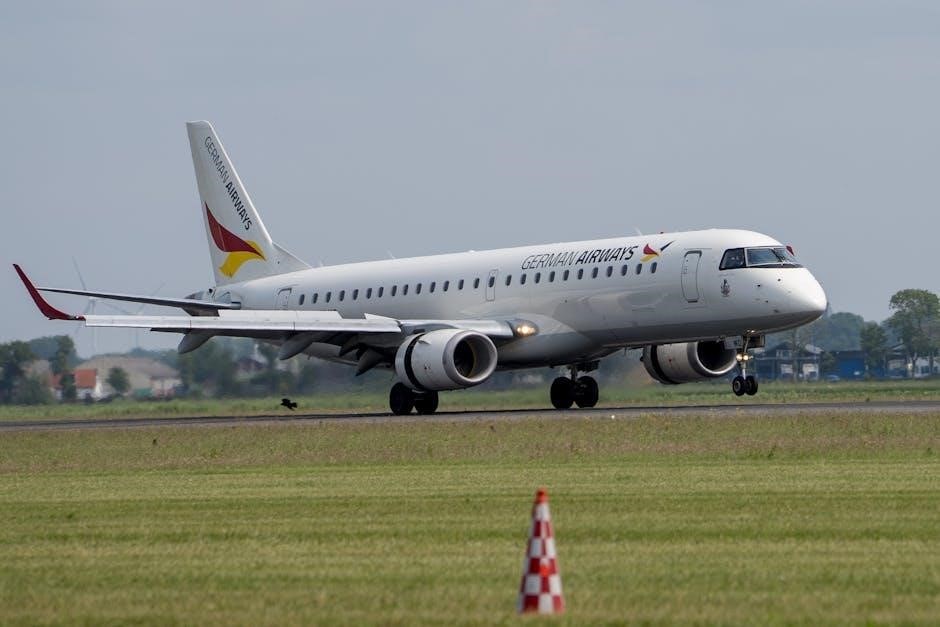A V-n diagram illustrates the relationship between airspeed and load factor, defining an aircraft’s flight envelope and structural limits. It’s crucial for ensuring safety and performance in various flight regimes, providing a visual representation of allowable maneuvers and speed limits to prevent structural damage. This tool is essential for pilots and designers to understand the aircraft’s capabilities and operating boundaries.
What is a V-n Diagram?

A V-n diagram is a graphical representation of an aircraft’s flight envelope, plotting airspeed (V) against load factor (n). It delineates the aircraft’s operational limits, combining aerodynamic and structural constraints; The diagram consists of two primary curves: the parabolic stall boundary and the structural limit lines. The stall curve indicates the maximum angle of attack at various speeds, while the structural lines define the maximum allowable load factors. This tool is essential for understanding the aircraft’s performance capabilities and ensuring safe operation within defined limits. It visually represents the interplay between speed and load factor, providing critical data for pilots and designers to avoid exceeding structural or aerodynamic thresholds.
Importance of the V-n Diagram in Aircraft Design and Safety
The V-n diagram is a critical tool in aircraft design and safety, as it visually defines the operational limits of an aircraft. By plotting airspeed against load factor, it ensures the aircraft operates within safe structural and aerodynamic boundaries. This diagram is essential for determining the maximum allowable speeds during maneuvers and the effects of gust loads. It guides designers in optimizing aircraft performance while maintaining structural integrity. Pilots rely on the V-n diagram to avoid exceeding safe load factors, preventing potential structural damage. Additionally, it aids in compliance with airworthiness standards, ensuring the aircraft meets safety requirements for various flight regimes and conditions. Its accuracy is vital for both design validation and operational safety.

Components of the V-n Diagram
The V-n diagram includes axes, load factor curves, and defined limits. It features a parabolic stall curve, structural load lines, and gust envelopes, outlining safe flight boundaries.

Axes of the V-n Diagram
The V-n diagram features two primary axes: the horizontal axis represents airspeed (V), typically in knots, while the vertical axis shows the load factor (n). The airspeed axis ranges from the stall speed (Vs) to the maximum dive speed (Vd). The load factor axis indicates the maximum positive and negative g-forces the aircraft can withstand. These axes define the boundaries of safe flight operations, ensuring pilots stay within structural limits. The intersection of these axes creates a visual map of allowable maneuvers, critical for maintaining safety and performance. Understanding these axes is fundamental for interpreting the diagram accurately and applying it in real-world flight scenarios.
Load Factor and Airspeed Relationship
The V-n diagram illustrates the inverse relationship between load factor (n) and airspeed (V). At lower speeds, higher load factors are possible due to increased lift, but this decreases as speed increases. The diagram shows a parabolic stall curve, where load factor peaks at stall speed (Vs) and declines linearly with speed. Structural limits, represented by horizontal lines, cap the maximum load factors. This relationship ensures pilots avoid exceeding the aircraft’s structural integrity. The diagram also highlights the transition point, where the stall curve meets the structural limit, marking a critical boundary for safe flight operations. This intersection is vital for understanding the aircraft’s performance envelope and operational constraints.
Understanding the Curves and Lines in the V-n Diagram
The V-n diagram features distinct curves and lines that define the aircraft’s operational boundaries. The parabolic stall curve represents the maximum load factor (n) at various speeds, peaking at stall speed (Vs) and decreasing as speed increases. Horizontal lines indicate structural load limits, showing the maximum positive and negative load factors the aircraft can withstand. The diagram also includes gust lines, which represent the aircraft’s response to vertical gusts at different speeds. These curves and lines collectively define the flight envelope, ensuring pilots operate within safe limits. The intersection of these elements highlights critical performance boundaries, such as the corner point where the stall curve meets the structural limit, guiding safe and efficient flight operations.

Construction of the V-n Diagram
The V-n diagram is constructed by plotting airspeed (V) against load factor (n). It begins with calculating stall speed (Vs) and structural load limits, then defining the flight envelope based on these parameters to ensure safe operation within designated boundaries.
Data Collection for Plotting
Data collection for plotting a V-n diagram involves gathering critical aircraft performance and structural parameters. Stall speed (Vs) at various configurations is determined through flight tests or wind tunnel experiments. Structural load limits, including maximum positive and negative load factors, are derived from design specifications and material strength analysis. Gust load data, accounting for atmospheric turbulence, is also incorporated to ensure safe operations. Weight, altitude, and aircraft configuration significantly influence these values, requiring comprehensive data across different flight regimes. This information is essential for accurately defining the flight envelope and ensuring compliance with airworthiness standards. Precise data ensures the V-n diagram reflects the aircraft’s true capabilities and limitations, safeguarding both the aircraft and its occupants during maneuvers.

Plotting the Diagram
Plotting the V-n diagram involves mapping airspeed against load factor, creating a visual representation of the aircraft’s performance and structural limits. The process begins by plotting the stall speed (Vs) at various load factors, forming a parabolic curve that transitions to a horizontal line at higher speeds. Structural load limits, such as maximum positive and negative load factors, are added as horizontal lines. Gust load lines, representing turbulence effects, are also included. These elements collectively define the flight envelope, ensuring safe operation within specified boundaries; The diagram is typically plotted on graph paper or using specialized software, with axes labeled for airspeed and load factor. This step is critical for accurately visualizing the aircraft’s capabilities and limitations, ensuring compliance with safety standards.
Defining the Flight Envelope
The flight envelope, as depicted on the V-n diagram, represents the aircraft’s operational limits in terms of airspeed and load factor. It is defined by the intersection of stall speeds, structural load limits, and gust load lines. The envelope ensures the aircraft operates within safe and controllable conditions, preventing structural damage. The stall curve forms the lower boundary, while the structural load limits define the maximum allowable load factors. Gust lines indicate the aircraft’s tolerance to turbulence. By staying within this envelope, pilots ensure the aircraft’s structural integrity and safe performance during maneuvers. The flight envelope is critical for understanding the aircraft’s capabilities and limitations under various flight conditions.
Structural Limitations and Load Factors
The V-n diagram delineates the aircraft’s structural limitations through load factor boundaries. The horizontal line represents the maximum positive and negative load factors, which are the aircraft’s structural limits. These limits are determined by the aircraft’s design strength and are critical for preventing structural damage. The load factor, defined as the ratio of aerodynamic force to the aircraft’s weight (n = V/g), must remain within these bounds. The maximum positive load factor is typically higher than the negative, as aircraft structures are stronger in positive G conditions. Exceeding these limits risks structural failure. The terminal speed limit forms a vertical boundary, ensuring the aircraft does not exceed its design capabilities. These structural limitations are essential for safe operation and are defined by rigorous testing and analysis.
Incorporating Gust and Maneuvering Speeds
Gust and maneuvering speeds are critical components of the V-n diagram, ensuring the aircraft can withstand environmental and operational stresses. Gust speeds, determined by atmospheric conditions and altitude, are plotted as lines on the diagram, representing the aircraft’s ability to endure sudden wind changes without structural damage. Maneuvering speed (Va) is the maximum speed at which the aircraft can safely withstand full control deflections. This speed varies with weight and configuration, forming a boundary within the flight envelope. The intersection of gust and maneuvering speeds defines the aircraft’s operational limits, ensuring safety during turbulence and aggressive maneuvers. These factors are essential for defining the aircraft’s performance and structural integrity.

Factors Affecting the V-n Diagram
Aircraft weight, configuration, and altitude significantly influence the V-n diagram. Weight affects stall and maneuvering speeds, while configuration changes alter aerodynamic characteristics. Altitude impacts air density, modifying speed limits and load factors, ensuring safe operation across varying conditions.
Aircraft Weight and Configuration
Aircraft weight and configuration significantly impact the V-n diagram. Increased weight raises stall speeds and reduces maneuvering capabilities, altering the shape of the parabolic stall curve. Configurations, such as flaps or landing gear deployment, change aerodynamic characteristics, shifting the diagram’s boundaries. For instance, extending flaps increases drag and reduces stall speed, while retracting them enhances cruise efficiency. Weight distribution also affects load factors, as heavier aircraft may have lower structural limits. These factors necessitate precise calculations to ensure the V-n diagram accurately reflects the aircraft’s performance under varying conditions, providing pilots with clear operational limits and ensuring structural integrity during maneuvers.

Altitude and Atmospheric Conditions
Altitude and atmospheric conditions significantly influence the V-n diagram by altering air density and temperature, which affect aircraft performance. At higher altitudes, lower air density reduces the aircraft’s ability to generate lift, increasing stall speeds. Temperature variations also impact engine performance and aerodynamic efficiency. Additionally, atmospheric turbulence and gust conditions, which vary with altitude, are critical factors in determining load factors. The V-n diagram must account for these changes to ensure safe operation across different flight regimes. Pilots and designers use these adjustments to define operational limits accurately, maintaining structural integrity and performance under diverse environmental conditions. This ensures the aircraft operates safely and efficiently in various atmospheric scenarios.
Flight Regimes and Maneuver Types
Flight regimes and maneuver types play a crucial role in shaping the V-n diagram, as different maneuvers impose varying load factors on the aircraft. Cruising at constant altitude typically involves low load factors, while aerobatic maneuvers or sharp turns demand higher load factors. The diagram accounts for both positive and negative load factors, ensuring the aircraft can withstand forces during climbs, dives, and rolls. Additionally, gust loads during turbulent flight are integrated into the V-n diagram, providing margins of safety. By defining these limits, the diagram ensures the aircraft remains within its structural capabilities across all intended maneuvers and flight conditions, enhancing safety and performance.

Applications of the V-n Diagram
The V-n diagram is a critical tool for defining flight envelopes, ensuring structural integrity, and aiding in airworthiness compliance. It guides pilots on safe operating limits and informs aircraft design, ensuring safety across all flight conditions.
The V-n diagram is essential for defining an aircraft’s flight envelope, which represents the permissible combination of airspeed and load factor during flight. By plotting these parameters, the diagram visually establishes the aircraft’s operational boundaries, ensuring safe and efficient flight. The flight envelope is divided into regions based on aerodynamic and structural limitations, such as stall speeds and maximum load factors. Pilots and designers use this data to avoid maneuvers that could exceed the aircraft’s design capabilities. Factors like weight, altitude, and configuration influence the shape of the envelope. Compliance with these limits ensures structural integrity and safe operation across various flight regimes.
Pilot Guidance and Operating Limits

The V-n diagram provides critical guidance for pilots by establishing clear operating limits, ensuring safe and effective aircraft operation. Load factor and airspeed boundaries are visually represented, helping pilots avoid maneuvers that could stress the aircraft beyond its structural limits. The diagram also highlights maximum and minimum allowable speeds for various load factors, preventing stalls or excessive structural stress. By adhering to these limits, pilots can execute maneuvers safely, whether in normal or extreme conditions. This visual tool enhances situational awareness and decision-making, crucial for maintaining aircraft integrity and passenger safety during all phases of flight.
Structural Analysis and Safety Margins
The V-n diagram is essential for structural analysis, as it defines the aircraft’s load factor limits at various airspeeds, ensuring safety margins are maintained. It visually represents the maximum positive and negative load factors the aircraft can endure without risking structural damage. Engineers use this data to assess the aircraft’s strength and ensure compliance with airworthiness standards. By identifying the boundary between safe and unsafe operations, the diagram provides a critical tool for evaluating the structural integrity under different flight conditions. This ensures that the aircraft can withstand expected maneuvers and gust loads, maintaining safety and preventing potential structural failure during operation.
Compliance with Airworthiness Standards
The V-n diagram plays a pivotal role in ensuring compliance with airworthiness standards by defining the aircraft’s structural and aerodynamic limits. Regulatory bodies mandate specific load factors and airspeed constraints, which are visually represented in the diagram. This ensures the aircraft operates within safe boundaries, meeting certification requirements. The diagram incorporates factors such as maximum load factors, gust speeds, and maneuvering limits, all of which are critical for airworthiness certification. By adhering to these standards, the V-n diagram verifies that the aircraft’s design and performance are aligned with safety regulations, ensuring reliability and structural integrity during various flight conditions.
The V-n diagram is an essential tool for ensuring aircraft safety and performance, providing clear boundaries for airspeed and load factors. Its application continues to evolve with advancements in aviation technology, maintaining its critical role in modern aircraft design and operation.
The V-n diagram is a critical tool in aircraft design and safety, illustrating the relationship between airspeed and load factor. It defines the aircraft’s flight envelope, structural limits, and allowable maneuvers. Key components include the stall curve, structural load limits, and gust lines. Construction involves data collection, plotting, and defining the flight envelope. Factors like weight, altitude, and configuration influence the diagram. Its applications include pilot guidance, structural analysis, and compliance with airworthiness standards. The V-n diagram ensures safe operation by providing clear boundaries for airspeed and load factors, making it indispensable for both designers and pilots. Its relevance endures as aviation technology advances.
Future Trends in V-n Diagram Development
Future advancements in V-n diagrams will likely focus on integration with digital tools and real-time data systems. The use of artificial intelligence and machine learning could enhance predictive capabilities, optimizing load factor and airspeed calculations. Automated data collection and simulation software will streamline diagram construction, reducing errors and improving accuracy. Additionally, the development of adaptive V-n diagrams tailored to specific aircraft configurations and flight conditions may become more prevalent. These innovations aim to enhance safety, efficiency, and compliance with evolving airworthiness standards. As aviation technology progresses, the V-n diagram will remain a cornerstone of aircraft design and operation, ensuring safer and more efficient flight envelopes.
